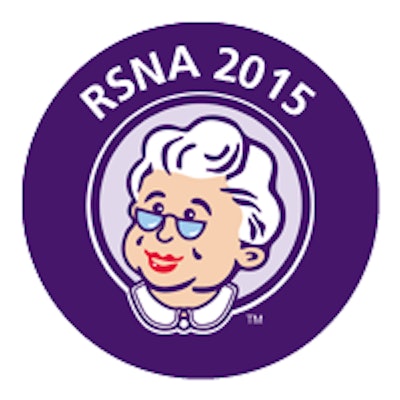
CHICAGO - Nodules detected with CT at interim lung cancer screening carry more than twice the risk of nodules present at the first scan, according to new research presented at this week's RSNA 2015 meeting.
Researchers from the University of Groningen in the Netherlands looked at nodules detected in more than 7,500 participants in the Nederlands-Leuvens Longkanker Screenings Onderzoek (NELSON) trial who were scanned at one, three, and 5.5 years. They compared the likelihood of cancer in solid nodules detected at interval screening with nodules that were present at the baseline scan, and found that newly detected nodules carried more than twice the risk of malignancy.
Nodules detected at interval screening "carry a substantially higher risk of malignancy than baseline nodules," said Dr. Marjolein Heuvelmans, from University Medical Center Groningen, in her talk.
 Dr. Marjolein Heuvelmans from Groningen University Medical Center.
Dr. Marjolein Heuvelmans from Groningen University Medical Center.Previous studies have reported on the incidence of nodules in interim screening, noting malignancy rates between 1.7% and 6.5% for newly detected nodules at interval screening. However, different studies define new nodules by different criteria, and the risk of malignancy in newly detected nodules is unclear.
The current study sought to determine the occurrence of new solid nodules and the respective lung cancer rates in the incident screening rounds of a large, randomized, low-dose lung cancer screening trial. Histology served as the reference for lung cancer diagnosis.
The investigators considered 1,222 solid nodules that were newly detected at one of the incident scans after baseline in 787 participants, including 4.7% of participants who developed a new nodule one year after initial scanning, and 7.1% of participants who had a new nodule three years after the baseline scan.
The mean age of participants with new nodules was 59 years, and they had a median 39 pack-years of smoking history. In almost half of the participants who developed a new nodule, not a single nodule was present at baseline screening, Heuvelmans said. In contrast, participants without new nodules had an average of one nodule at baseline.
Smokers with a malignant nodule detected at interim screening had smoked for more pack-years (43.7), compared with those who had new nodules diagnosed as benign (38.7). Most detected cancers from new nodules were adenocarcinomas (39%, 30/77), squamous cell carcinomas (26%, 20/77), or small cell lung cancers (11.7%, 9/77); 62.3% (48/77) of these cancers were diagnosed at stage I.
All told, a lung cancer diagnosis was made in 50 individuals with a new solid nodule, Heuvelmans said.
"Participants with lung cancer smoked more pack-years and had surprisingly more often no nodules present at the baseline screening compared to participants with benign new nodules," she said. Per participant, lung cancer probability among all newly detected nodules was 6.2% (compared with about 2.6% overall in multiple screening studies).
The risk of cancer was higher for nodules detected in the second interval screening (7.1%, 491/6,922) versus the first interval screening (4.7%, 344/7,295). The newly detected nodules also grew faster, Heuvelmans said, promising to release precise details of the growth rates and nodule sizes in a separate upcoming RSNA session.
"New solid nodules are a common finding in low-dose CT lung cancer screening and carry a substantially higher risk of malignancy than baseline nodules," Heuvelmans said. "For the guidelines, we need to consider a new, more-stringent follow-up for these nodules."



















